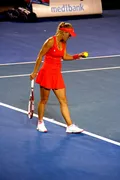33 years after Steffi Graf's Olympic gold medal, Alexander Zverev won gold for the first time in men's singles tennis at the Summer Olympics in Tokyo. His victory in the semifinals against the Serbian number one in the world rankings, Novak Djokovic, was decisive. Everything already looked like a two-set defeat when Zverev was trailing 2:3 in the second set. After a break (loss of game despite serving), Zverev first thundered his racket on the floor, then shot a tennis ball out of the stadium with full force.
"Choking under pressure" is the term used to describe the phenomenon when an athlete fails to perform to his or her full potential at a crucial moment in a match. Prof. Dr. Jürgen Beckmann's Sport Psychology Unit has been analyzing this phenomenon for about ten years now, also looking for solutions.
"We have already been able to show the effect of a dynamic hand grip on right-handed athletes with the left hand in various sports such as gymnastics, taekwondo, badminton, golf or beach volleyball," said Prof. Beckmann. "Our idea was now to apply this hand grip to tennis as well. For this, the test persons dynamically pressed the tennis ball with their left hand directly before the serve."
The results of this study have now been published in the journal "PLOS ONE" under the title "Preventing a loss of accuracy of the tennis serve under pressure". The journal has an impact factor of 3.240.
In 2013, the effect of this dynamic hand grip in badminton was first published. "In 2017, we then looked at the accuracy of the serve in beach volleyball," explained Dr. Vanessa Wergin, a Research Associate in the Sport Psychology Unit and co-author of the publication. "In the current study, we now analyzed the accuracy of the tennis serve, which should be placed as close as possible to a given target."
The study participants were 20 male cadre athletes from Baden-Württemberg, aged between 17 and 18, who play in at least the fourth-highest league in Germany and train between four and six times a week.
"The advantage of tennis, of course, is that the players already have a ball in their hands anyway," Dr. Wergin said. "The firmness of the tennis ball is also great for the dynamic hand grip. The higher the resistance, the stronger the effect in the end."
In the study, participants were divided into two groups. One group practiced the dynamic hand grip with the left hand with the tennis ball for ten to 15 seconds immediately before serving, while the second group actively squeezed the racket grip with the right hand for ten to 15 seconds.
Subsequently, both groups each performed eight serves with a given target in the pre-test without pressure, followed by another eight serves in the post-test under pressure.
The distance of valid serves from the target of the right-handed group increased significantly from pretest to posttest, indicating a decrease in performance, while the accuracy of valid serves of the left-handed group remained stable.
"The original assumption was that the right hemisphere of the brain favors a holistic execution of a highly automated movement, while the left hemisphere tends to lead to a dissection of the execution of the movement through linguistic representation, which then impairs the flow of the movement and leads to greater inaccuracy," explained Prof. Beckmann. Thus, pressing the left hand in right-handers should result in greater activation of the right hemisphere of the brain.
"However, further EEG studies by our Sport Psychology Unit have shown that rather a relaxation effect, a reset mechanism so to speak, occurs as a result of left-handed dynamic hand squeezing," said Dr. Wergin. "That is, the brain goes into alpha rhythm and thus relaxation occurs. There's a lot of evidence to suggest that this effect occurs in right-handed people because there's more white brain matter in their right hemisphere, and therefore higher connectivity."
This causes the relaxation effect to spread throughout the cortex. This reduces conscious control of the execution of the serve via the left hemisphere of the brain.
"The findings are of high practical importance, as it shows the applicability of the dynamic left hand grip in actual tennis competitions," Prof. Beckmann summarized the results. "The hand grip could easily be used as a strategy to prepare the next serve in a regular tennis match. It could become part of a service routine that players normally perform before serving."
It is not known whether Alexander Zverev already uses the dynamic hand grip. However, after his emotional outbursts in the second set, he finally managed to turn things around against Djokovic. The Hamburg native won the second set 6:3 and decided the third set 6:1 in his favor to enter the Olympic final. There he defeated the Russian Karen Khachanov clearly with 6:3 and 6:1.
To the publication „Preventing a loss of accuracy of the tennis serve under pressure“ in the journal „PLOS ONE“
To the homepage of the Sport Psychology Unit
Contact:
Prof. Dr. Jürgen Beckmann
Sport Psychology Unit
Georg-Brauchle-Ring 60/62
80992 München
phone: 089 289 24540
e-mail: Juergen.Beckmann(at)tum.de
Dr. Vanessa Wergin
Sport Psychology Unit
Georg-Brauchle-Ring 60/62
80992 München
phone: 089 289 24547
e-mail: Vanessa.Wergin(at)tum.de
Text: Romy Schwaiger
Photos: Pixabay/private


